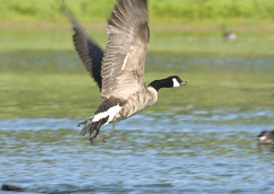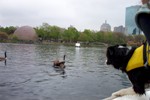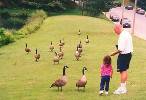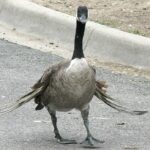-
Adopt
-
Veterinary Care
Services
Client Information
- What to Expect – Angell Boston
- Client Rights and Responsibilities
- Payments / Financial Assistance
- Pharmacy
- Client Policies
- Our Doctors
- Grief Support / Counseling
- Directions and Parking
- Helpful “How-to” Pet Care
Online Payments
Referrals
- Referral Forms/Contact
- Direct Connect
- Referring Veterinarian Portal
- Clinical Articles
- Partners in Care Newsletter
CE, Internships & Alumni Info
CE Seminar Schedule
Emergency: Boston
Emergency: Waltham
Poison Control Hotline
-
Programs & Resources
- Careers
-
Donate Now
Many communities have successfully resolved geese conflicts humanely. Killing geese, in contrast, is not only inhumane, but it merely opens up prime habitat to new geese. One of the most effective, humane geese management tools is the GeesePeace program, which aims to “devise means for wildlife to live benignly in the transitional space with minimal harm to the wildlife or disruption of the human community, wildlife habitat or natural areas.” The MSPCA has successfully partnered with Geese Peace in improving geese conflicts in the Commonwealth, such as in Worcester and on the Esplanade.
GeesePeace is an adaptive management program and consists of three main components: population stabilization, site aversion, and habitat modification. Public education of the importance of not feeding geese is an important component as well. Additionally, it is important to ensure that the community understands that the objective is to reduce goose nuisance to an acceptable level, not to eliminate all geese from a community, which is impossible. Therefore, tools will be most effective when targeted at specific conflict sites.
ONE: POPULATION STABILIZATION
The first part of the GeesePeace program curtails the goose population through egg addling, which ensures that no new goslings are born by coating eggs in the first two weeks of development with corn oil. An egg addling program is easy to operate and low-cost; only a handful of volunteers or staff members are needed to start an egg addling program.
Addling is an important part of geese management for two reasons. First, it keeps the geese population from growing and, second, it decreases the loyalty adult geese have to a certain site. Adult geese with no new goslings are moved off of a conflict site relatively easily.
See here for a detailed guide to egg addling.
Note that Canada geese eggs (and most bird eggs) are protected, so you must register online with the U.S. Fish and Wildlife Service and obtain a state permit from MassWildlife. Many towns, apartment complexes, pond owner associations, etc. have successfully received this permit. (These requirements apply to all geese in Massachusetts.)
TWO: SITE AVERSION
The second part of the program turns areas that were once geese havens into unfriendly territory. Site aversion is most effective in the spring before nesting season (nesting happens from late March to mid May) and in the summer after the molting season when geese have regained their flight feathers. (Molting season runs roughly from mid-June to early August.)
The site aversion component of the GeesePeace program is best accomplished through the use of a border collie, who geese view as predators. It is important that the collies chase geese both on land and in the water; geese consider water bodies to be their prime safety zones and so a little aversion in that setting can go a long way. Using a border collie service can be expensive, but Massachusetts towns have approached the challenge in creative ways. For example, Sharon bought a border collie from a reputable service and the service trained the seasonal staff on how to handle the dog. Roy became the town’s mascot and one of the main attractions in the town’s annual parade. Some towns have been successful in recruiting dedicated volunteers who work with a dog for the community at no charge. Partnerships can also be made among town parks, school districts, local businesses and private and municipal golf courses who can share the expense and maintenance of a border collie service.
If using a border collie, or other trained bird dog service, isn’t feasible, there are still many other actions that can be taken. Putting out flags, tying aluminum pie plates along strings, and using scarecrows may help keep geese away from an area. It’s important, however, to change up the aversive stimuli regularly as geese will learn if an object poses no threat. Full bodied swan or coyote decoys can also be effective because geese consider these animals to be predators. As with flags, etc. it’s important to move decoys periodically or the geese will realize they aren’t real. For a more active approach, try walking up to the birds and flapping a tablecloth or creating loud noises. Lasers and other light-emitting devices specifically designed to scare birds can also be useful, especially at dusk, can also be a useful tool.
THREE: HABITAT MODIFICATION
The third main pillar of the Geese Peace approach is habitat modification, which essentially means making the area less attractive to geese in the first place. Geese walk to their feeding sites from water and will rarely fly over a fence (especially during the summer molting period) and they generally like to be able to see around obstacles, in order to be able to keep an eye out for predators. Therefore, barriers can be a powerful habitat modification tool. For example, a hedge or swath of uncut weeds/tall grass in between the water and mowed grass creates a natural, low maintenance barrier. A 3-foot chicken wire fence can also be effective, as well as dense tall plantings along the shoreline. Read more about egg addling, site aversion, and habitat modification in this HSUS advocacy toolkit.
COMPLEMENTARY STRATEGIES
Eliminate Human Feeding
Geese will often move elsewhere once supplemented food handouts are removed and they are forced to depend on the area’s natural food supply. Anti-feeding ordinances can be helpful in restricting feeding, as well as public outreach and education, such as informative signage and pamphlets.
Public Education
It can be valuable to explain why feeding geese is problematic. With regard to human health, feeding encourages more geese to congregate in one area, which means more droppings. Though researchers have not found any significant health threats from goose feces, it is still best to avoid exposure. In a physical safety sense, geese are not inherently dangerous to people, but they will vigorously defend their nest and goslings, and feeding Canada geese can actually make them more aggressive as their natural fear of people decreases.
Human feeding is also harmful to the birds themselves. An inappropriate diet can lead to a permanent wing deformity called dropped wing, which limits or even prevents flight. (See photo.) More generally, a larger proportion of the diet of human-fed geese is made up of “empty calories.” This “junk food” can lead to the same health problems that people face if they are not able to eat healthfully.
Identify Tolerance Zones
The impact of habitat modifications can be boosted if geese can find an alternative “tolerance zone” that meets their needs. If geese can be left undisturbed in tolerance zones they will be more likely to vacate low-tolerance zones.
WHY ROUNDUPS ARE INHUMANE AND INEFFECTIVE
When Canada geese are deemed a nuisance or threat, they are sometimes rounded up to be killed. The geese are typically packed in crates and killed by carbon dioxide gas (a painful and distressing death).
Beyond being inhumane, these roundups are also ineffective and a waste of taxpayer money. While they may provide a temporary fix, roundups are not a long-term solution as they merely open up prime real estate to other geese.
In sum, when addressing geese conflict in a community it is best to take a multi-pronged approach. The management program should always include egg addling, site aversion, and habitat modification, and may benefit from some of the above complementary strategies as well. One should expect that there will be some trial and error involved as communities figure out what balance of different approaches work best for them.
ADDITIONAL RESOURCES
- Access HSUS’s Coexisting with Canada Geese Advocate Toolkit
- Detailed guide to egg addling
- Learn more about waterfowl
- Learn more about Canada geese
- Find resources about other Massachusetts wildlife
- Download our fact sheet
- Watch the MSPCA’s educational video on resolving geese conflicts: Part 1 and Part 2
- More questions? Contact us.









